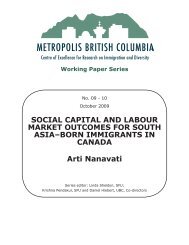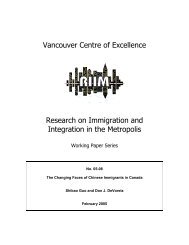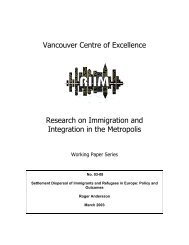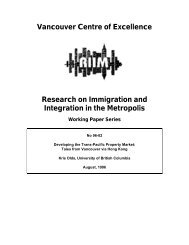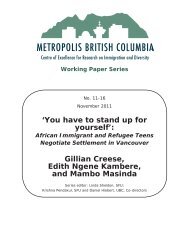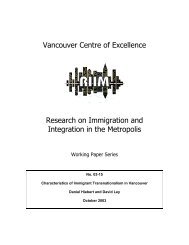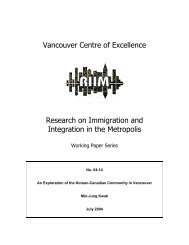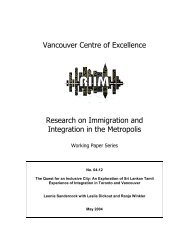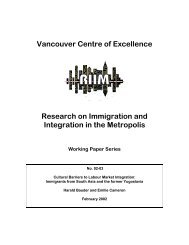Religion in Migration, Diasporas and Transnationalism - Metropolis BC
Religion in Migration, Diasporas and Transnationalism - Metropolis BC
Religion in Migration, Diasporas and Transnationalism - Metropolis BC
You also want an ePaper? Increase the reach of your titles
YUMPU automatically turns print PDFs into web optimized ePapers that Google loves.
4<br />
Jews liv<strong>in</strong>g among Greeks (Modrzejewski 1993) – <strong>and</strong> galut imply<strong>in</strong>g <strong>in</strong>voluntary movement due to a<br />
conquest of the territory that was/is considered home (Marienstras 1989).<br />
Nevertheless, the overall Jewish history of displacement has embodied the longst<strong>and</strong><strong>in</strong>g,<br />
conventional mean<strong>in</strong>g of diaspora. Mart<strong>in</strong> Baumann (1995) <strong>in</strong>dicates that there have been at least<br />
three <strong>in</strong>herent, <strong>and</strong> rather different referential po<strong>in</strong>ts with respect to what we refer to as the Jewish (or<br />
any other group’s) historical experience “<strong>in</strong> the diaspora.” That is, when we say someth<strong>in</strong>g has taken<br />
place “<strong>in</strong> the diaspora” we must clarify whether we refer to (a) the process of becom<strong>in</strong>g scattered, (b)<br />
the community liv<strong>in</strong>g <strong>in</strong> foreign parts, or (c) the place or geographic space <strong>in</strong> which the dispersed<br />
groups live. The k<strong>in</strong>d of conceptual muddle that may arise from the failure to dist<strong>in</strong>guish these<br />
dimensions with regard to historical Jewish phenomena cont<strong>in</strong>ues to plague the many emergent<br />
mean<strong>in</strong>gs of the notion of diaspora.<br />
Academics have, <strong>in</strong> the term diaspora, found a useful concept through which to reorganize<br />
their research <strong>in</strong>terests. This cuts across discipl<strong>in</strong>es. The term has proliferated <strong>in</strong> conferences <strong>and</strong><br />
publications with<strong>in</strong> Anthropology, Sociology, Cultural Studies <strong>and</strong> Political Science. In 1999, by way<br />
of further example, the American Historical Association (AHA) held its annual conference on the<br />
theme “<strong>Diasporas</strong> <strong>and</strong> <strong>Migration</strong>s <strong>in</strong> History”. The Chairman of the organiz<strong>in</strong>g committee, John O.<br />
Voll, said he received literally hundreds of session proposals <strong>and</strong> was surprised by their diversity:<br />
“Everywhere we looked, <strong>in</strong> almost every subfield, people wanted to talk about diasporas,” he said (<strong>in</strong><br />
W<strong>in</strong>kler 1999). However, not all of his colleagues welcomed the trendy topic: at the open<strong>in</strong>g plenary<br />
of the 1999 AHA meet<strong>in</strong>g, Col<strong>in</strong> A. Palmer op<strong>in</strong>ed that “Diaspora is a problem that <strong>in</strong>vites a great<br />
deal of methodological fuzz<strong>in</strong>ess, ahistorical claims, <strong>and</strong> even romantic condescension” (<strong>in</strong> W<strong>in</strong>kler<br />
1999).<br />
Another account of the grow<strong>in</strong>g popularity of the term comes from Kachig Tölölyan, the<br />
editor of the academic journal entitled Diaspora. Tölölyan (1996: 3) has witnessed the fact that “The<br />
rapidity of material <strong>and</strong> discursive change <strong>in</strong> the past three decades has <strong>in</strong>creased both the number of<br />
global diasporas <strong>and</strong> the range <strong>and</strong> diversity of the new semantic doma<strong>in</strong> that the term ‘diaspora’<br />
<strong>in</strong>habits.” Once, as it were, there were three “classic diasporas” studied by social scientists – the<br />
Jewish, Greek <strong>and</strong> Armenian. By 1998 (only seven years after its launch), Tölölyan’s journal had<br />
covered no less than thirty-six communities who had been identified by academics as, or who have<br />
called themselves, “diasporas” (Kachig Tölölyan, personal communication). These numbers pale <strong>in</strong><br />
comparison to other examples of the discursive expansion of “diaspora” <strong>in</strong> the public sphere. At the<br />
time of writ<strong>in</strong>g this paper, a simple AltaVista search of the Internet turns up no less than 102,435 web<br />
pages concerned with the term “diaspora”. Irish, “African”, Ch<strong>in</strong>ese, Filip<strong>in</strong>o, Indian, Arab, Tamil,



